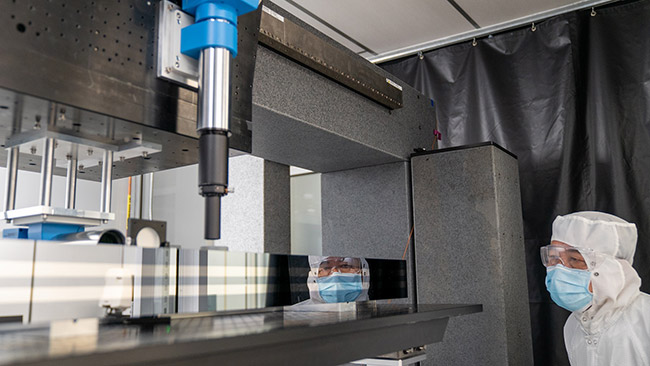
Advanced Photon Source to Get Highly Polished Upgrade
To support the massive upgrade of the Advanced Photon Source (APS) facility at the U.S. Department of Energy’s (DOE) Argonne National Laboratory, the APS optics team has begun the monumental task of building a state-of-the-art optical system — essentially from scratch.
The upgraded APS will deliver x-ray beams that are up to 500× brighter than those generated at the current facility. The beams from the upgrade will not only be more powerful — they will also be more tightly focused.
The team is building a system that can focus extremely intense beams down to spot sizes smaller than a single micron. To achieve this level of performance, the APS will require new technology and a newly designed system of mirrors, lenses, and other optical components.
“All of the beamlines — including nine newly built ones and 15 with significant enhancements — will be state of the art, and designed to do something we couldn’t do before,” said Lahsen Assoufid, leader of the Optics Group in Argonne’s x-ray science division.
“We are designing all-new optics for the nine new beamlines. There are no existing optics we can reuse for them.”
The newly designed optics system must be able to maintain the coherence of the light beam even at extremely small beam sizes. Coherence — the characteristic of light that allows it to carry information when it bounces off surfaces — will ensure that the beam can capture and deliver detailed information about a sample.
“We want to make sure that a coherent beam is preserved,” Assoufid said. “I think that’s the biggest challenge. We want the mirrors to preserve the beam quality in the focusing optics. We want all this coherent light in a small spot size, to speed up measurement time.”
The APS upgrade involves more than 1700 lenses and nearly 60 highly polished mirrors. To preserve the qualities of the beam, the mirrors must be almost perfectly smooth. For some mirrors, this means that atoms must be removed from the mirror’s surface one by one.
Such a demanding design goes well beyond traditional mechanical chemical polishing. According to Assoufid, only one company in the world can deliver the smoothness required for some of the mirrors; about 20 mirrors for the APS will come from that company. According to Argonne, it takes about one year to make these mirrors, and if a mirror doesn’t pass inspection, the company will need to start over almost from scratch.

Jun Qian, metrology engineer in the APS Optics Group at Argonne, observes his reflection in one of the highly polished mirrors for the APS upgrade. These mirrors will focus the powerful APS x-ray beams to incredibly small sizes. Courtesy of J.J. Starr/Argonne National Laboratory.
The requirements for the lenses are not quite as stringent, although their design and manufacture are still extremely detailed. For the beam to focus as intended, the lenses’ concave design must be created exactly to specifications.
The components for the APS light source are installed in experiment end stations called beamlines, located around the APS. Physicist Xianbo Shi is designing several of the new optical systems for the APS with the help of the staff at each beamline. To make the design process more efficient, the team has developed its own software.
Using AI, the team is developing a way to allow some beamlines to change the size of the beam quickly and precisely, without the need for the user to adjust the beam. ATOMIC, one of the new beamlines, is designed to probe the structural, chemical, and physical properties of samples with unprecedented precision, which could require quick, on-the-go adjustments to the beam size.
“Beamline scientists don’t have time to align the mirrors, so it has to be done automatically,” Assoufid said. “If they want to focus the beam in one spot, and then change the size, they can image their sample at different scales.”
The team will test the mirrors and lenses at the APS and also test the components using traditional optical metrology methods. Each mirror can take a week or more to test, using tools and technology developed by the team specifically for this purpose. The team also created new diagnostic systems for measuring each of the beamlines.
“The beam quality is important, so we need a way to measure it,” Shi said. “We spent some effort on developing a new wavefront testing technology. It improves on the state of the art. We can monitor the beamline when changing optics and gather information to control those optics.”
The team plans to install the new mirrors, lenses, and other equipment during the one-year period when the APS is shut down for upgrade construction. The installation period is scheduled to begin in April 2023. The APS is currently scheduled to come back online in 2024. Once the upgrade is complete, the APS will generate an x-ray source that is about 10 μm vertically and 30 μm horizontally.
Scientists from around the world will be able to use its tightly focused, extremely bright beams to uncover the properties of novel materials for new devices, for example, or to help develop the next generation of medicines.
Published: September 2021